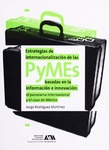Mostrar el registro sencillo del ítem
Estrategias de internacionalización de las PyMEs basadas en la información e innovación: el panorama internacional y el caso de México
| Autor: | Rodríguez-Martínez, Jorge |
| Fecha de publicación: | 2013 |
| Sugerencia de citación: | Rodríguez Martínez, J. (2013). Estrategias de internacionalización de las PyMES basadas en la información e innovación: el panorama internacional y el caso de México. México: UAM Azcapotzalco. |
| dc.identifier.isbn | 978-607-28-0157-8 |
| URI: | http://hdl.handle.net/11191/6043 |
| Descripción: | 252 páginas. |
| Resumen: | Las empresas pequeñas y medianas (PyMEs) debido a su tamaño se han enfocado tradicionalmente a sus mercados domésticos; sin embargo, en las últimas décadas han incrementado su participación en los mercados internacionales, ya que se han beneficiado enormemente de un proceso internacional de integración que ha intensificado la competencia forzando a que las empresas reduzcan sus costos y su tamaño, su estrategia se basa frecuentemente en proveeduria, con el propósito de ofrecer productos y servicios innovadores con buen diseño. El libro se divide en dos secciones. La primera parte, presenta los resultados de una extensa encuesta postal en cinco países: Francia, Finlandia, Reino Unido, Australia y México. El estudio se presenta desde la perspectiva del dueño o director, el principal tomador de decisiones y la fuerza que inspira a que la compañía incursione en otros países. Se analizó la forma y el tipo de información que se adquiere, ya que esta es un prerrequisito para la internacionalización. Es de llamar la atención las similitudes que se encontraron en las características personales de los directores. La segunda parte, se basa en la internacionalización de las PyMEs mexicanas que exportan productos o servicios. Su énfasis es en la estrategia de innovación que aplican a sus productos, procesos o mercadotecnia. La ultima sección presenta un caso de estudio de diseñadores o estudios de diseño mexicanos con actividades internacionales. El diseño es una herramienta estratégica para diferenciar un producto y que puede hacer más amable la interfaz con el usuario. |
| Resumen: | Small and medium-sized enterprises (SMEs) have traditionally focused their activities on their domestic markets. However in the last few decades SME shave become increasingly active in international markets. This is due, in part, to the worldwide trend of large companies to downsize, to outsource activities and processes, and to offshore them. SMEs have benefited immensely from a worldwide process of economic, financial, cultural and technological integration. From a holistic perspective, internationalization is both an inward and outward process. The first part of this work focuses on the SME manager or owner, who is the key decision-maker in the SME and the driving force in its internationalization. A large postal survey 2,500 questionnaires was conducted in five countries: UK, France, Finland, Australia and Mexico. Remarkable similarities were found in the characteristics of the SME manager. He is likely to be a middle-aged, well-educated male, with a degree in engineering or business. He speaks a foreign language, is well travelled and may have well lived abroad. The information acquisition of the SME manager was analyzed, as information is a prerequisite in the internationalization of the SME. The managers, wherever they are, have very similar needs and problems, have similar education, apply similar management theories and have access to similar education. The second part covers only Mexican SMEs and its internationalization activities. A strategy commonly used is differentiation, based on the innovation of products, services, processes, organizational changes, and marketing strategies. Design has also become an important element to foster innovation and is commonly used as strategic competitive tool. However, in the case of Mexican firms, design-driven internationalization has not been strongly applied and rarely explored by the academic literature. Some information regarding the participation of Mexico in the creative economy is presented; it occupies the 9th place among top exporters within developing economies. The case here presented, is focused on design offices and individual designers. A total of 200 design studios were contacted using an electronic survey, with a response rate of less than 10%. The mam objective of this paper is to analyze the strategies used by Mexican design directors or independent designers to internationalize their products or services. The personal characteristics of the director are presented, as the key person in the decision making process in internationalization. This group of designers tends to be well educated, several with postgraduate studies abroad; most of them are young; bilingual; and are looking for international markets for their ideas. Survey sections are: innovation activities and its results; use of ICT; ways to finance innovation, and international experiences. Some design entrepreneurs have already established offices abroad, fostering the presence of Mexican design at international levels. |
| Formato: | |
| Idioma: | spa |
| Editor: | Universidad Autónoma Metropolitana (México). Unidad Azcapotzalco. |
| Palabras clave: | SMEs; Information; Mexican design; Internationalization; Differentiation strategies; Innovation. |
| Materias: | CIENCIAS SOCIALES::CIENCIAS ECONÓMICAS::ECONOMÍA INTERNACIONAL::OPERACIONES COMERCIALES INTERNACIONALES |
| Clasificación LC: | HD2346.M4 |
| Materias: | Small business--Mexico. |
| Materias: | Pequeñas y medianas empresas -- Administración. |
| Materias: | Pequeñas y medianas empresas -- Crecimiento. |
| Materias: | Comercio internacional. |
| Materias: | Mercado de exportación. |
| Título: | Estrategias de internacionalización de las PyMEs basadas en la información e innovación: el panorama internacional y el caso de México |
| Tipo de publicación: | Libro |
| Audiencia: | students |
| Audiencia: | researchers |



